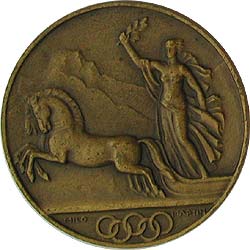|

|

|
|
|
|
|
|
Medal Information |
| |
Summer Olympics
1896 Athens, Greece
1900 Paris, France
1904 St.Louis, USA
1906 Athens, Greece
1908 London, England
1912 Stockholm, Sweeden
1920 Antwerp, Belgium
1924 Paris, France
1928 Amsterdam, Netherlands
1932 Los Angeles, USA
1936 Berlin, Germany
1948 London, England
1952 Helsinki, Finland
1956 Melbourne, Australia
1960 Rome, Italy
1964 Tokyo, Japan
1968 Mexico City, Mexico
1972 Munich, Germany
1976 Montreal, Canada
1980 Moscow, USSR
1984 Los Angeles, USA
1988 Seoul, Korea
1992 Barcelona, Spain
1996 Atlanta, USA
2000 Sydney, Australia
Winter Olympics
1924 Chamonix, France
1928 St.Moritz, Switzerland
1932 Lake Placid, USA
1936 Garmisch, Germany
1948 St.Moritz, Switzerland
1952 Oslo, Norway
1956 Cortina, Italy
1960 Squaw Valley, USA
1964 Innsbruck, Austria
1968 Grenoble, France
1972 Sapporo, Japan
1976 Innsbruck, Austria
1980 Lake Placid, USA
1984 Sarajevo, Yugoslavia
1988 Calgary, Canada
1992 Albertville, France
1994 Lillehammer, Norway
1998 Nagano, Japan
2002 Salt Lake City, USA
| |
|
|
|
|
1928 WINTER OLYMPIAD
ST. MORTITZ, SWITZERLAND
|

Hold mouse over image to view reverse.
If the image does not load, simply hit refresh.
|
Composition: | Bronze |
Shape: | Round |
Diameter: | 37 mm |
Thickness: | 3 mm |
Weight: | 22 grams |
Edge: | Plain |
Mintage: | 1,500 ? |
Designer: | Milo Martin |
|
|
| DESCRIPTION |
The now-famous Olympic emblem (five interconnecting rings) would appear for the first time on an Olympic Medal. The obverse depicts the figure of “Victory” holding a laurel branch while standing on a horse-drawn sled. The Olympic rings and the designer’s name lie at the lower edge. The reverse has the legend II / JEVX / OLYMPIQVES / D’HIVER / St. MORITZ / 1928 inscribed above a laurel branch. The medal was presented in a tan cardboard box.
|
THE GAMES |
The 1928 Winter Games, hosted by St. Moritz, Switzerland, were the first to be held in a different nation than the Summer Games of the same year. A new event was contested: the skeleton, which is like luge, except the athletes descend headfirst. Speed skater Clas Thunberg added two more gold medals to the three he had won in 1924. Johan Grøttumbråten of Norway won both cross-country events and the Nordic combined. Another Norwegian, Sonja Henie, caused a sensation by winning the women’s figure skating at the age of fifteen. Her record as the youngest winner of an individual event stood for 74 years. In men’s figure skating, Gillis Grafström of Sweden won his third straight gold medal. Canada again dominated the ice hockey tournament, winning their three matches 11-0, 14-0 and 13-0.
|
|
|
| |
